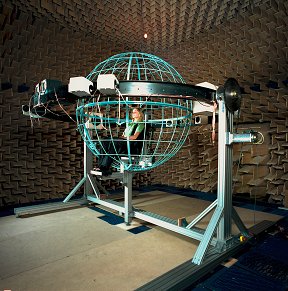Applications of interference
We have seen that sources can be adjusted so as to control the acoustic environment created. From these basic principles, Virtual Imaging Systems can be designed, in which one can produce the illusion for a listener of being in a “virtual” acoustic environment which is entirely different from that of the space in which the listener is actually located. The following picture shows practical working systems being tested during a series of subjective experiments in the ISVR.
The subject is being played sounds from loudspeakers located around the sphere, and synthesised sounds which appear to come from other locations. By checking the responses of many subjects like this it has been possible to test how effective the system is.
Another application of the principle of wave superposition is Active Noise Control. It is based on the fact that the pressure waveform generated by a primary source (such as an engine) can be cancelled by the pressure waveform emitted by a secondary source (loudspeakers) driven at the same frequency as the primary source, but with a phase shift of 180 degrees so that the acoustic pressures cancel each other out. This technique has been applied to reduce the annoying noise inside the cabin of propeller aircraft. Similar effects can be achieved by vibrating the fuselage of the aircraft. As shown on the picture below, a noticeable reduction of sound pressure levels has been measured when the active noise control system is on (right picture) compared with it switched off (left picture). On this picture, the blue color corresponds to low noise levels while the red color corresponds to high noise levels.

